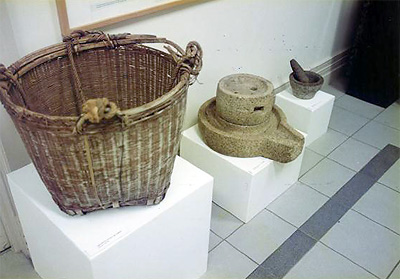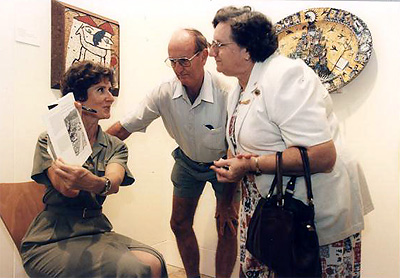|
Read more, Astronauts Lost Souls & Dragons'There is currently in Australia an upsurge of activity in the gathering and recording of their histories by Chinese Australians themselves. They have moved in a very short time from being interviewed and written about to becoming proactive in the reclamation of their own pasts. Answers to my questions are increasingly being offered from within Chinese Australian communities, something that counterpoints and parallels the rediscovery of hidden histories of other groups, such as Aborigines and women. So I also include oral history of the process of making histories, reflecting on the excitement of retrieving heritages that often seemed to have been lost. Many such projects have grown out of the family histories too long dismissed as amateur and inconsequential, subjective and sentimental. Increased access to cheaper technology, such as budget video cameras, puts new media within the reach of almost anyone with motivation. Striving for the best possible result from an amateur oral history or video recording, then seeking selective professional help, can supplement the feeling and spontaneity of personal history work, resulting in significant contributions to the historical record.
The structure of this book is not linear; these are not chronological life stories. Those with whom I talked tend to define themselves most fully in particular areas of their lives. So Annette Shun Wah spoke at length of her long march into television through the jungles of commercial radio. Most of her story is incorporated into the section on Industry. The Kwong Sue Duk researchers, by contrast, mostly chose to describe themselves in relation to their family history project, their personal reclamation of their heritage through the rediscovery of the life of "the historical Kwong". Their stories appear in Reclaiming the Past and Families. A story begun in the section on Identities may continue later: he or she will be Imagining the Future. Readers will gradually get to know the people with whom I was in conversation, slowly finding out who they are, rather like an unfolding relationship. By the end of the book, they should know quite a lot about its major "characters", whose outline biographies are given there. Throughout, there is also a dialogue, a constant counterpoint between them and others who make briefer appearances, sketched, profiled or merely mentioned. My "characters" range in age from teenagers to people in their eighties. They come from around Australia, from Cairns to Perth to Melbourne, from Bendigo to Alice Springs to Darwin. Major informants such as the Kwong Sue Duk researchers come from north Australia, where Chinese people have been so vital in community development. But urban voices emerge just as strongly from achievers in Sydney and Melbourne. Voices, like themes, overlap and complement one another, echoing and resonating from time to time and place to place. The older generation includes elder community statesmen, successful businesspeople and a Church leader; the middle generation the overseas student made good, the developer, the professor; the energetic younger generation the painter, the film-maker, the marine biologist and the Chinese scholar who has read more Australian literature than most Australians. The overall criteria for my idiosyncratic selection was what each person had to share, the stories they had to tell that were emblematic, that would reveal something of life in Australia today for Chinese Australians. Moni Lai Storz does not "represent" the famously entrepreneurial Malaysian Chinese Australian community, but her activities and attitudes can tell us much about why they are so prominent and successful. Norma King Koi and Warren Lee Long do not "represent" the younger Chinese all round the country who are reclaiming their heritage, but in their drive, dedication and professionalism, and their compelling need to know who they are and where they come from, they tell us something abut the grip of tradition on even the most educated and assimilated. Zhou Xiaoping, roaming between north and south Australia, from outback to suburb, visually exploring his new world in paintings which are a breakthrough fusion of Chinese brush painting and Aboriginal art forms, does not "represent" the restless energy of the newest arrivals from the mainland, but tells us much about it. Annette Shun Wah, blasting her way through the fast-changing world of the media, working simultaneously for multicultural broadcaster SBS and the ABC, does not in her plans for exciting futures, "represent" the new Chinese woman—but she powerfully suggests what she might be like. Moni Lai Storz and internationally acclaimed film-maker Clara Law use Melbourne as their Australian base, but are more international businesspeople than any national type. These and the other "characters" are not mere interviewees but, with their frank opinions and quirky takes on life, are active collaborators in the ways their words have been shaped…
Alongside the words of oral history and my comments and contextualistion, I also use extracts from printed works, including fiction which imagines Chinese Australian voices, for so long silent in our literature, into cacophonous life. As Dai Yin notes, this has not always been the case. These extracts include the fiction writer’s voice of Moni Lai Storz and Dai Yin’s own scholar’s voice. I have occasionally ranged beyond Australia to the Chinese diaspora, to the ironic, knowing comments of Singapore writer Catherine Lim on the changing Chinese family, and to Lynn Pan, that acutest observer of things Chinese. The short opening section of the book, Arriving, provides quick glimpses of some of the ways people of Chinese background have entered this country. Through his fictional character Shan, Brian Castro vividly portrays the shock of landfall. Much later in Birds of Passage, Shan encounters his descendant, O’Young, and their parallel stories link past and present. Taam Sze Pui, in one of the most poignant documents to have come out of Chinese Australia, dramatises the immense difficulties of contending with the harshness of an entirely alien place, the stoicism, courage, persistence and resilience required to endure and prevail. As Darwin businesswoman Pam Con Foo says, looking back: "They had to go over it or around it. Otherwise, they had nothing." Eddie Quong imagines what this must have been like. Jumping ahead almost a century, King Fong, then Moni Lai Storz arrived with excited anticipation in a prosperous Australia, "the lucky country". But in the midst of the affluence of the 1960s, Storz found Melbourne "the coldest, loneliest place" she had ever encountered. Today, secure and successful, looking back from the big, beautiful house she shares with her husband, she can still remember the eager innocent she was then. Tac Tam Lam is also a success. Barely twenty years after his flimsy boat fetched up in Darwin Harbour, he is the owner of three restaurants, one interstate, and takes parties of businessmen back to Vietnam with a view to setting up joint ventures. Clara Law’s whole Hong Kong family has now made its home in this country. Dai Yin, landing in Perth with its clear, bright light, recaptures his first impressions of wonder and delight.'
|
|||||||||
|
|
||||||||||




